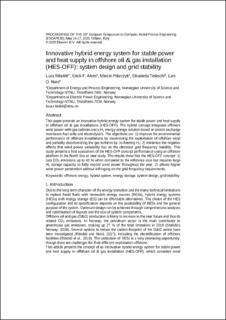| dc.contributor.author | Riboldi, Luca | |
| dc.contributor.author | Alves, Erick Fernando | |
| dc.contributor.author | Pilarczyk, Marcin | |
| dc.contributor.author | Tedeschi, Elisabetta | |
| dc.contributor.author | Nord, Lars O. | |
| dc.date.accessioned | 2020-11-04T09:08:35Z | |
| dc.date.available | 2020-11-04T09:08:35Z | |
| dc.date.created | 2020-11-03T15:17:27Z | |
| dc.date.issued | 2020 | |
| dc.identifier.citation | Computer-aided chemical engineering. 2020, 48 211-216. | en_US |
| dc.identifier.issn | 1570-7946 | |
| dc.identifier.uri | https://hdl.handle.net/11250/2686301 | |
| dc.description.abstract | This paper presents an innovative hybrid energy system for stable power and heat supply in offshore oil & gas installations (HES-OFF). The hybrid concept integrates offshore wind power with gas turbines and a H2 energy storage solution based on proton exchange membrane fuel cells and electrolysers. The objectives are: 1) improve the environmental performance of offshore installations by maximizing the exploitation of offshore wind and partially decarbonizing the gas turbines by co-feeding H2; 2) minimize the negative effects that wind power variability has on the electrical grid frequency stability. This study presents a first assessment of the HES-OFF concept performance using an offshore platform in the North Sea as case study. The results show that the HES-OFF concept: 1) cuts CO2 emissions up to 40 % when compared to the reference case but requires large H2 storage capacity to fully exploit wind power throughout the year; 2) allows higher wind power penetration without infringing on the grid frequency requirements. | en_US |
| dc.language.iso | eng | en_US |
| dc.publisher | Elsevier | en_US |
| dc.rights | Attribution-NonCommercial-NoDerivatives 4.0 Internasjonal | * |
| dc.rights.uri | http://creativecommons.org/licenses/by-nc-nd/4.0/deed.no | * |
| dc.title | Innovative Hybrid Energy System for stable Power and Heat Supply in offshore oil & gas Installation (HES-OFF): System Design and Grid Stability | en_US |
| dc.type | Peer reviewed | en_US |
| dc.type | Journal article | en_US |
| dc.description.version | acceptedVersion | en_US |
| dc.source.pagenumber | 211-216 | en_US |
| dc.source.volume | 48 | en_US |
| dc.source.journal | Computer-aided chemical engineering | en_US |
| dc.identifier.doi | https://doi.org/10.1016/B978-0-12-823377-1.50036-7 | |
| dc.identifier.cristin | 1844599 | |
| dc.relation.project | Norges forskningsråd: 281986 | en_US |
| dc.description.localcode | © 2020. This is the authors’ accepted and refereed manuscript to the article. Locked until 19.10.2022 due to copyright restrictions. This manuscript version is made available under the CC-BY-NC-ND 4.0 license http://creativecommons.org/licenses/by-nc-nd/4.0/ | en_US |
| cristin.ispublished | true | |
| cristin.fulltext | postprint | |
| cristin.qualitycode | 1 | |

